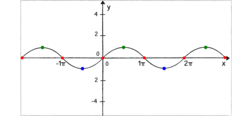Fun with infinite sets
 Imagine the graph of function the
f
(
x
)
=
sin
(
x
)
.
The domain of this function is the set of all real numbers
R
.
Imagine the graph of function the
f
(
x
)
=
sin
(
x
)
.
The domain of this function is the set of all real numbers
R
.
Consider the three sets
- A = { x ∈ R ∣ sin ( x ) = − 1 }
- B = { x ∈ R ∣ sin ( x ) = 0 }
- C = { x ∈ R ∣ sin ( x ) = 1 } .
Which of them has the largest cardinality?
This section requires Javascript.
You are seeing this because something didn't load right. We suggest you, (a) try
refreshing the page, (b) enabling javascript if it is disabled on your browser and,
finally, (c)
loading the
non-javascript version of this page
. We're sorry about the hassle.
4 solutions
Can the option be B because from the graph we can see that 0 is included and adds one more to the cardinality , I mean:
B = { 0 , π , 2 π } ,
However, all other sets are : A,C = { ± 2 π , ± 2 3 π , ...... }
Log in to reply
Not with the definition of cardinality.
Two sets A and B are said to have the same cardinality if there exists a bijection A → B .
One possibility is y = 2 x − π with x ∈ A & y ∈ B
Sine is a periodic function, meaning that it repeats itself at interger multiples of 2*pi. So a way to think of it is just purely about it's interger parts. Another thing you will notice is that it seems as though there are twice as many that crosses zero as oppose to one. Well we could actually say that there are just as many points that pass through zero as there are points that equal 1. And same goes for -1.
How? Imagine if I asked you to tell me why there are an equal amount of sheeps and cows. The reason why we say they are equal is because for every cow, we can also pair it up with a sheep with a 1 to 1 correspondence. If I told you to tell me if I can pair all the natural numbers with all the even number, all one has to do is pair every natural number n to 2n. You can also pair every interger with every natural number. Let's try that. {1,-1,2,-2,3,-3,....} We can pair 1 with 1, 2 with -1, 3 with -2, and so on.
Now let's apply our pairing game to this. It becomes clear how we can pair all the points where f(x)=0 and all the points where f(x)=1. Same goes for -1.
I’m on mobile so I won’t type too much, but for anyone who’s struggling with this question, it will likely help if you instead show that there’s a bijection between each set and the integers, and then you can pretty easily make a bijection between any two of the sets.
- Given f(x)= sinx is a trignometric function which is a periodic function with a principal range of [-1,1]. It repeats in every interval of 2pi and have a general solution 2npi +_ x. Therefore, each of them repeats at each interval with the given values 3pi/2 +_ 2npi=(-1) , 2npi=0 and pi/2+_ 2npi = 1.
I can prove only in the case x be integer that the member of A will satisfy 2 π ( 3 + 4 x ) , B will satisfy x π and C will satisfy 2 π ( 1 + 4 x ) . Given that the integer is an infinite set, A, B and C will also be infinite set.